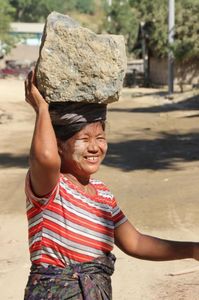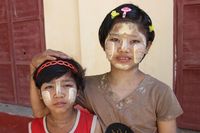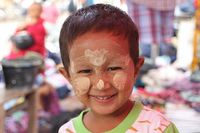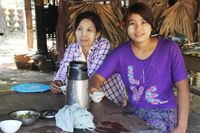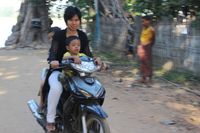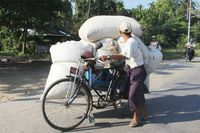Myanmar
We flew Air Asia from Bangkok Don Muang Airport to Mandalay (1hr 55m, clock back 30 mins). Mandalay airport is empty with no shop to even buy any water. Air Asia provide a courtesy coach into Myanmar which takes about 1 hour. The road is a dual carriageway which is empty of any traffic until you reach Mandalay. The bus crew dropped us off and kindly spoke with a taxi driver to tell him of our final destination.
We arrived at RV Thurgau Exotica II at 2pm and Rainer, Cruise Director, kindly let us onboard to our cabin. The other 22 guests arrived at 5.15 complete with their sickness bug! Upon arrival, most were cabin bound grateful of the clean, spacious bathroom. 6 of us had dinner but the final 4 of the group departed feeling ill, leaving us dining alone. The prime suspect of the food poison/virus was the Kandawgyi Palace Hotel in Yangon where they all stayed the previous evening. The following day, there were only 3 of the group (plus us) on the morning tour. Many of the group missed most or all of the 2 days tours in Mandalay.
Few tourists have ventured the length of the river from Mandalay to Yangon and even fewer on the stretch from Pyay to Yangon (the cruises travelling north start at Pyay). It was a rare glimpse into the Asia of yesteryear, where Buddhism remains the way of life and both men and women wear traditional longyis. Our 1000 km cruise was the perfect, most stress-free way to see Myanmar as it begins to emerge from years of repression and isolation.
Mostly the sandy coloured River Irrawaddy (Ayeyarwady) is about 500m wide but often only a few feet deep and is notorious for its whirlpools and submerged sandbars. The main channel is not marked; it shifts depending on how the sand moves after the monsoon rains. With no modern navigational aids the boat is navigated by the behaviour of the water and occasionally a member of the crew dipping a white, yellow and blue banded pole into the water and calling up the depth. Throughout the 1000 mile journey we had 11 different pilots.
Days on the river were never dull as we cruised past the villages, gold and white stupas on the hillsides and temporary huts built on the riverbanks, whilst watching the assortment of boats, the fishermen, the farmers ploughing the silt-rich riverbanks to plant peanuts as the water level falls, and the people washing their clothes, hair and teeth in the river.
The primary tourist sights are the countless temples and stupas and your eyes start to glaze over them towards the end of the trip. Our shore exclusions were interesting and varied including numerous villages, workshops, monasteries and markets using all kinds of transport including horse and cart, rickshaws and trishaws. Markets presented unfamiliar fruit and vegetables arranged like works of art. Incense and smoke from the street cooking fills the air. In the larger cities the streets are crammed with spluttering trucks, overloaded bicycles, mopeds, tuk-tuks and pickups, red-robed monks and women carrying heavy loads on their heads.
Foreign tourists are still a novelty in the area and the warm welcome we got was very touching. They were just as keen to see us as we were to see them as we exchanged greetings of ‘Mingalabah’ (a form of hello) to most people that you pass. The people have great charm and natural warmth and were only too happy to pose for a photo.
At one temple in Bagan a lady took me to a toilet facility and when I offered her money as a thank you, she refused. Likewise, a fellow traveller didn’t want to buy a post card from a boy so offered him some money but the boy refused. In contrast, our first initiation with a beggar boy happened at Pyay further down river towards Yangon, but generally there was next to no begging, compared with almost all other places we’ve been to.
Burmese cuisine is unknown outside its borders – it’s a fascinating fusion of Indian, Thai and Chinese influences, with plenty of noodle, rice-based dishes and exceptionally mild curries.
1.5M tourists were expected in 2013 up from 816K in 2011 and 1M in 2012, approximately half come in from the borders and half from flights into Yangon. 15% of tourists are from Thailand, 12% China, 8% Japan, with others from Korea, Malaysia, France, Singapore and the UK.
While Myanmar may now claim to have an elected civilian government, it would still appear to be a country not free from oppression. All of the land is owned by the government and much of the larger private businesses are owned or controlled by the military.
The Mandalay people are hopeful of change
with the release of Aung Sang Suu Kyi and
her welcome of ‘responsible tourism’
to help with the future development of the
country. Mobile phones, internet, ATM’s
and renovated or new hotels are cropping
up so one hopes that the process of change
will not be too fast thus enabling the people
to adapt. As a comparison of 20 years ago,
a sim card for a phone cost $8,000 and is
now $150. Petrol was $12 for a gallon, restricted
to 10 litres a day so there was a big black
market and now it is $5. A second hand Japanese
import car was $60,000 to $100,000 and now
it is about $10,000 however, imports are
restrict to about 30,000 a year and they
have to be left-hand drive. There are many
old vehicles on the roads.
In a few years, I wonder what Myanmar will
look like and how the people will have changed.
Will that little boy and the old lady still
refuse to accept the donation offered to
them? Will tourists still exchange greetings
of ‘Mingalabah’?
Freedom comes at a cost.
|
|











